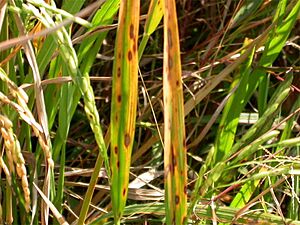Cockspur facts for kids
Quick facts for kids Cockspur |
|
|---|---|
 |
|
| Scientific classification | |
| Genus: |
Echinochloa
|
| Species: |
crus-galli
|
| Varieties | |
|
|
| Synonyms | |
|
|
Echinochloa crus-galli is a type of wild grass. It originally comes from tropical Asia. People often call it cockspur grass or barnyard millet. You might also hear it called Japanese millet or water grass. This plant can grow quite tall, up to 1.5 meters (about 5 feet). It has long, flat leaves that are sometimes purple near the bottom. Its stems usually grow straight up, but some can spread along the ground.
Barnyard grass is known as one of the world's worst weeds. It can seriously harm farm crops. This grass takes away a lot of important nutrients, like up to 80% of the soil nitrogen, which crops need to grow. It can also cause problems for forage crops (plants grown for animal food). Barnyard grass can also carry diseases that affect other plants. If there's a lot of this grass, it can even make it hard for farmers to harvest their crops with machines.
A single barnyard grass plant can make up to 40,000 seeds in a year! These seeds spread in many ways. Water, birds, insects, farm machinery, and even animal feet can carry them. However, the most common way it spreads is through contaminated crop seeds.
Contents
What Barnyard Grass Looks Like
Barnyard grass is a tough, tufted (meaning it grows in clumps) plant that lives for one year. It often grows as a weed. Its stems can be 0.8 to 1.5 meters tall and are usually thick. They can grow straight up or spread out.
The leaves are flat and smooth. They are long, about 30–50 centimeters (12–20 inches) long and 1–2 centimeters (0.4–0.8 inches) wide. The edges of the leaves are a bit rough. This grass does not have ligules, which are small flaps at the base of the leaf blade found in many grasses. The lower parts of the leaf sheaths (the part of the leaf that wraps around the stem) are often reddish.
The seed heads are a key feature. They are 8–30 centimeters (3–12 inches) long and can be green or purple. These heads are full of tiny flowers and seeds, packed closely together. The individual seed clusters, called spikelets, are 3–4 millimeters long. They are often pale green to dull purple and can have long, bristle-like parts called awns. Each plant can produce up to 40,000 seeds, which ripen in September and October.
Where Barnyard Grass Grows
Barnyard grass is very common in tropical Asia and Africa. You can find it in fields, along roadsides, in ditches, near railway lines, and in places where the ground has been disturbed, like gravel pits or dumps. It also grows along riverbanks and the edges of lakes and ponds. This grass is found in almost all farming areas around the world.
In North America, it is considered an invasive species, meaning it grows where it's not native and can harm the local environment. It is found all over the continental United States and in southern Canada, from British Columbia to Newfoundland. It was first seen in the Great Lakes region in 1843.
How Barnyard Grass Lives
This grass can grow in many different climates, from cool, moist areas to very dry tropical forests. It loves wet places and is often found as a common weed in paddy fields (rice fields), along roads, in cultivated areas, and in empty fields. It grows well in ditches, low-lying fertile farmlands, and wet waste areas, often even growing in water. While it can survive in cool regions, it prefers areas where the average yearly temperature is around 14–16 °C (57–61 °F). The type of soil pH (how acidic or basic the soil is) does not limit where it can grow.
How People Use Barnyard Grass
Believe it or not, E. crus-galli was actually grown as a crop in Hokkaido, Japan, about 4,500 years ago!
Today, this warm-season grass is often used as cattle fodder (food for livestock). Sometimes, farmers even grow it just for this purpose. It's good for making silage (fermented animal feed), but not ideal for hay (dried animal feed). Animals can eat it fresh, and it provides food all year round. Hay made from this plant can be stored for up to six years. This grass is also used to improve salty and alkaline (basic) soils, especially in Egypt.
Wild animals also enjoy eating barnyard grass. Rabbits, deer, and waterfowl (like ducks and geese) all readily eat it.
In some places, people eat the seeds of certain varieties, especially when other food is scarce. The roots can be boiled to help with indigestion in the Philippines. Young shoots are eaten as a vegetable in Java. In India, barnyard grass is a traditional folk remedy for various issues, including carbuncles (skin infections), bleeding, sores, spleen problems, cancer, and wounds.
In the Hisar district of India's Haryana state, the seeds of this grass are commonly mixed with cultivated rice to make rice pudding or khir. This is often eaten on Hindu fast days.
Barnyard grass was one of the five most important crops grown during the Joseon Dynasty in Korea. The Rural Development Administration in South Korea found that eating barnyard grass can help lower blood sugar and cholesterol levels.
Japanese barnyard millet (Echinochloa esculenta), which is a domesticated form of E. crus-galli, is grown on a small scale in Japan, Korea, and China. Over thousands of years in Japan, people carefully selected and bred this plant to have larger grain sizes.
Diseases and Pests
This grass can get a disease called brown spot. It is caused by a fungal infection from Bipolaris oryzae.
Images for kids
See also
 In Spanish: Echinochloa crus-galli para niños
In Spanish: Echinochloa crus-galli para niños




